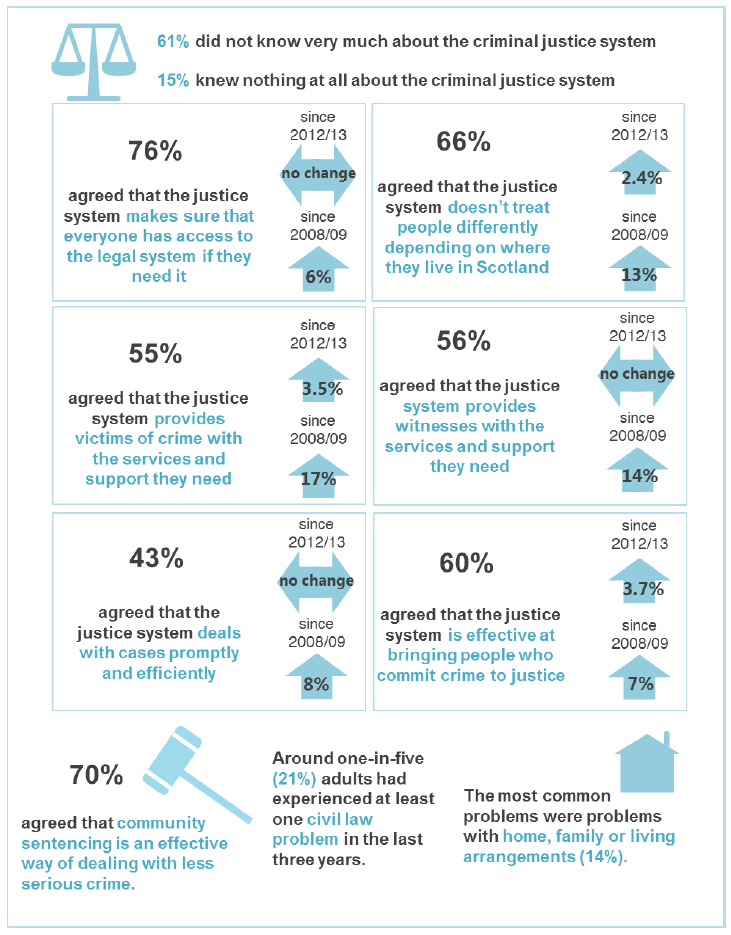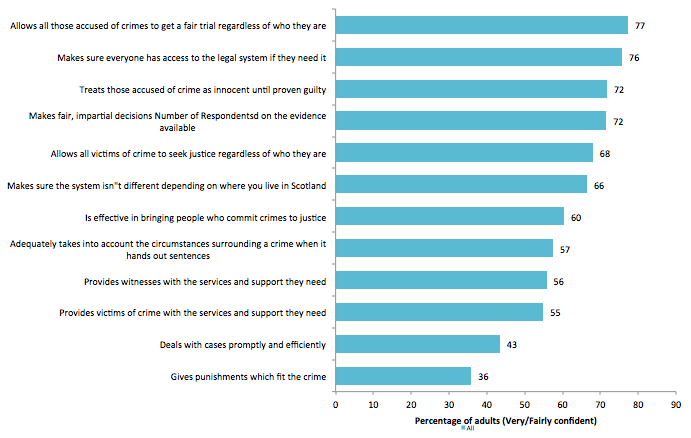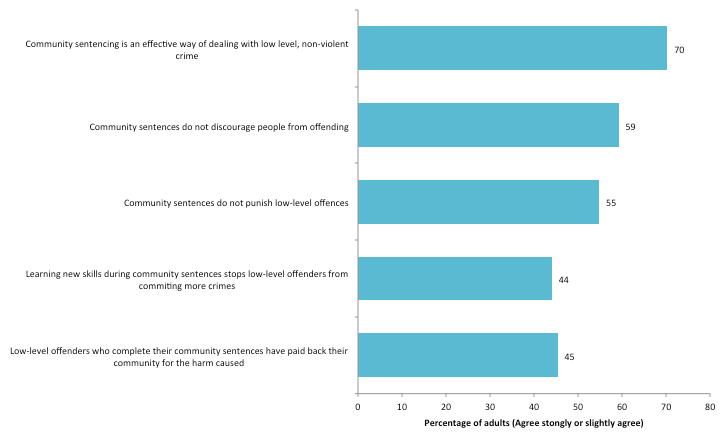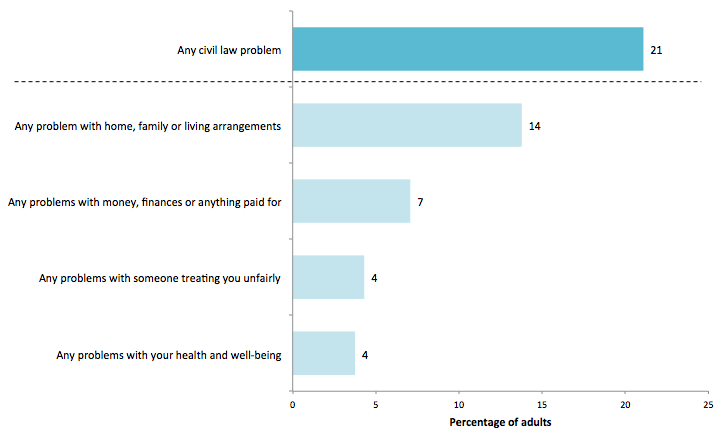Scottish Crime and Justice Survey 2014/15: Main Findings
Main findings from the Scottish Crime and Justice Survey 2014/15.
9. Scottish Justice System and Organisations

9.1. Introduction
This chapter explores public knowledge of, and attitudes towards, the criminal justice system in Scotland. The focus is on public experiences and perceptions of the justice system in Scotland, both criminal and civil.
9.2. The Scottish Criminal Justice System
The survey collects information on public knowledge of the criminal justice system and contact with different organisations operating within the system. The Scottish criminal justice system was defined to respondents as:
'The shared name for all the organisations in Scotland that deal with finding offenders and arresting them, then taking them through the court system and deciding what sentence they are given if they are found guilty, and carrying out that sentence.'
9.2.1. Knowledge of the Criminal Justice System
Respondents were asked how much they knew about the criminal justice system in general. The majority said that they did not know very much (61%) or knew nothing at all (15%) about the criminal justice system. Only 3% said that they knew a lot, while 21% said that they knew a fair amount.
9.2.2. Confidence in the Criminal Justice System
The survey looked at confidence in the criminal justice system as a whole through various statements about the perceived performance of the system.
Box 9.1: Trust in Justice
The trust that people have in 'justice' is critical to the effective operation of any criminal justice system. Trust in the idea of justice encourages victims and witnesses to report incidents to the police, to give evidence in court and to support the jury system. There is considerable support for the view that confidence in the criminal justice system has an important role in reinforcing acceptance and observance of the law. There is also a body of academic thought suggesting that people obey laws because of an underlying trust in the judicial process (for example, Roberts, & Hough, 2005; Tilly, 2005; Sunshine & Tyler, 2003; Beetham, 1991; Lind & Tyler, 1988).
Respondents, regardless of the level of contact they had with the criminal justice system, were asked how confident they were that the system delivered in 12 key areas. Figure 9.1 gives an overview of these findings.
Around three quarters of adults were either very or fairly confident that the system allows all those accused of crimes to get a fair trial (77%) or makes sure everyone has access to the criminal justice system if they need it (76%) or thought that it treats those accused of crime as innocent until proven guilty (72%). Three-fifths of adults (60%) thought it was effective in bringing people who commit crime to justice whilst just over a third (36%) were confident that it gives punishments that fit the crime.
Across many of these categories, the responses provided by victims of crime showed that they were less confident than non-victims. For example, 62% of non-victims were confident that the system is effective at bringing people who commit crime to justice, compared to 53% of victims.
Figure 9.1 Confidence with different aspects of delivery of the criminal justice system (SCJS (2014/15)

Base: Adults (11,470)
Variable name: QDCONF
Table 9.1 shows the difference in the results between 2008/09 and 2014/15. While 12 statements were posed to respondents in 2014/15, Table 9.1 shows the six statements which respondents were asked about in all previous surveys. In general, there is consistency in the levels of confidence between 2012/13 and 2014/15. However, agreement with some statements has risen slightly. Table 9.1 shows the changes in confidence in different aspects of the justice system since 2008/09 and since 2012/13, highlighting where changes are statistically significant.
Table 9.1 Confidence in different aspects of delivery of the justice system over time (SCJS 2014/15)
| Percentage point change | |||||||||
| Percentage of adults (Very/Fairly confident) | 2008/09 | 2009/10 | 2010/11 | 2012/13 | 2014/15 | 2008/09 to 2014/15 | 2012/13 to 2014/15 | ||
|---|---|---|---|---|---|---|---|---|---|
| Makes sure everyone has access to the legal system if they need it | 70 | 71 | 73 | 76 | 76 | 6 | * | 0 | |
| Makes sure the system doesn't treat you differently depending on where you live in Scotland | 54 | 55 | 57 | 64 | 66 | 13 | * | 2 | * |
| Is effective at bringing people who commit crime to justice | 53 | 53 | 56 | 57 | 60 | 7 | * | 4 | * |
| Provides witnesses with the services and support they need1 | 43 | 45 | 49 | 55 | 56 | 14 | * | 1 | |
| Provides victims of crime with the services and support they need1 | 38 | 41 | 45 | 52 | 55 | 17 | * | 4 | * |
| Deals with cases promptly and efficiently | 35 | 38 | 42 | 43 | 43 | 8 | * | 1 | |
| Number of Respondents | 16,000 | 16,040 | 13,010 | 12,050 | 11,470 | ||||
Variable name: QDCONF
Changes which are statistically significant at the 95% level are highlighted with an "*".
9.2.3. Contact with Courts
As shown in Table 9.2, just under one-in-five adults (19%) had attended the court, or had contact with the courts in the last three years. Of those, one quarter (25%) were called for jury service but were not selected, 18% were as a witness in a criminal case and 15% served as part of the jury.
Table 9.2 Reasons respondents had contact with the courts in the last three years (SCJS 2014/15)
| Percentage of adults who had contact with courts in last 3 years | All | Male | Female |
|---|---|---|---|
| Yes | 19 | 22 | 17 |
| While doing jury service called but not selected | 25 | 24 | 26 |
| As a witness in a criminal case | 18 | 16 | 19 |
| While doing jury service as part of jury | 15 | 13 | 17 |
| To support someone else attending court | 10 | 7 | 13 |
| As a victim in a criminal case | 6 | 5 | 7 |
| For other work or professional reasons (e.g. police or social workers) | 8 | 8 | 7 |
| Other | 4 | 3 | 4 |
| As an accused in a criminal case | 11 | 17 | 4 |
| As a defender in a civil case | 4 | 4 | 4 |
| As a witness in a civil case | 3 | 2 | 4 |
| As a spectator or tourist | 2 | 1 | 2 |
| As a pursuer in a civil case | 3 | 3 | 2 |
| Visiting a fines office or other public counter | 3 | 5 | 1 |
| As a member of the legal profession | 1 | 1 | 1 |
| No | 81 | 78 | 83 |
| Number of Respondents | 2,100 | 1,040 | 1,060 |
Variable names: QCRT, QCRTHOW
Notes: Multiple responses allowed
9.2.4. Prisons and Sentences
Respondents were asked whether they agreed or disagreed with a series of attitudinal statements about the effectiveness of prisons in Scotland for punishing and rehabilitating offenders, deterring people from committing crime and protecting the public from crime. These results are shown in Table 9.3.
Table 9.3 Public perceptions of the effectiveness of prisons (SCJS, 2014/15)
| Percentage of adults | Very confident | Fairly confident | Not very confident | Not at all confident | Don't know |
|---|---|---|---|---|---|
| Prisons are effective at punishing offenders who have been convicted of a crime | 9 | 40 | 31 | 16 | 5 |
| Prisons are effective at rehabilitating offenders who have been convicted of a crime | 3 | 25 | 43 | 19 | 9 |
| Prisons are effective at deterring people from offending | 6 | 29 | 39 | 21 | 5 |
| Prisons are effective at protecting the public from crime | 17 | 53 | 20 | 7 | 4 |
Number of Respondents: Adults (2,870)
Variable name: QPRIS_01, QPRIS_02, QPRIS_03, QPRIS_04
The response to the statements on prisons was varied. For example, Table 9.3 shows that respondents were generally confident in the role of prisons to protect the public from crime, with 70% saying that they were either fairly or very confident in this aspect of the prison service. However, around two-thirds of respondents were not very or not at all confident in the ability of prisons to rehabilitate offenders (63%) and deter people from offending (60%).
9.2.5. Community Payback Orders
Respondents were asked about community payback orders (CPOs), a community sentence designed to punish offenders in a way that pays the community while making offenders address and change their behaviour. Around a third (34%) of respondents were aware of CPOs, and 20% were aware of them being used in their area. Among those who knew about CPOs, most people came to know about them through word of month (41%) or having witnessed the work taking place (33%).
Respondents were asked whether they agreed or disagreed with a series attitudinal statements about community sentences. Figure 9.2 gives an overview of the percentage of respondents who either slightly or strongly agreed with these statements. Just over two thirds of adults (70%) agreed that community sentencing is an effective way of dealing with less serious crime, however, only 45% believed that offenders who complete their community sentences have paid back their community for the harm caused.
Figure 9.2 Attitudes to Community Sentences (SCJS 2014/15)

Base: Adults (2,870)
Variable name: QDISATT
9.2.6. Sentences
In 2014/15, the SCJS estimates that 6% of the adult population have been previously convicted of a crime[38], with men more likely to have been convicted than women (10% and 1% respectively).
Of the adults that have been previously convicted, the most common type of sentence received was a fine or other financial penalty (4%).
9.3. Civil Law
The survey also included a series of questions on experiences of civil law problems in Scotland, and how individuals responded to these problems.
Box 9.2 What are Civil Law Problems?
Respondents were asked about civil problems which may raise a legal issue or which, if not resolved earlier, could ultimately result in legal proceedings. Civil problems are wide ranging, including welfare rights, debt, housing, employment, divorce or separation and consumer issues. These types of problems are referred to as 'the problems of everyday life' (Pleasance et al., 2004)[39].
Dealing effectively with these problems is a key issue for the Scottish Government when making progress towards the National Outcomes set out in Scotland Performs. More specifically, helping to resolve people's civil problems will in many cases help take forward the recommendation from the tackling poverty framework, Achieving our Potential, to better integrate and so improve advice and support for people at risk of poverty and the recommendation from the report of the Debt Action Forum to take longer term action to better integrate services to meet people's needs[40].
Respondents were asked if, over the previous three years, they had experienced any of 16 named problems or disputes. They were then asked whether they attempted to solve them, if they used help and advice in that process and if so, who provided advice.
Further analysis of the answers to the SCJS civil law questions will be published as part of Civil Justice Statistics in Scotland scheduled for release in March 2016.
9.3.1. Experience of Civil Law Problems
Respondents were asked about their experiences of problems in different areas of their life in the three years prior to interview. The problems examined were grouped into four different areas:
- Home, family or living arrangements;
- Money, finance or anything paid for;
- Unfair treatment;
- Health and well-being.
Around one-in-five (21%) adults had experienced at least one of the civil law problems asked about in the last three years. Figure 9.3 shows the proportion of Scottish adults who had experienced the different types of civil problem, highlighting that the most common problems were problems with home, family or living arrangements (14%).
Figure 9.3 Experience of civil law problems in Scotland (SCJS 2014/15)

Base: Adults (5,750)
Variable name: QCVJUS1-4
Table 9.4 provides a further breakdown of the problems experienced, showing that, for example, problems with neighbours was the most common issue within the 'living arrangements' category, with 9% experiencing this over the last three years.
Table 9.4 Experience of civil law problems (SCJS 2014/15)
| Percentage of adults | |
|---|---|
| Any civil law problem | 21 |
| Any problems with home, family or living arrangements | 14 |
| Problems to do with neighbours | 9 |
| Problems to do with housing | 2 |
| Problems to do with the behaviour of a partner, ex-partner or other person who is harassing you | 2 |
| Problems to do with child contact, residence or maintenance | 1 |
| Problems to do with the education of your children | 1 |
| Other problems to do with divorce or separation | 1 |
| Immigration problems | 0 |
| Any problems with your health and well-being | 4 |
| Problems with injury because of an accident | 2 |
| Problems with issues surrounding mental health difficulties | 1 |
| Problems to do with medical negligence | 1 |
| Any problems with money, finances or anything paid for | 7 |
| Problems to do with money and debt, for example being owed money | 3 |
| Problems with faulty goods or services | 3 |
| Benefit problems | 2 |
| Any problems with someone treating you unfairly | 4 |
| Problems with discrimination | 2 |
| Problems to do with employment, other than finding work | 2 |
| Problems with unfair treatment by the police | 1 |
| Number of Respondents | 5,750 |
Variable name: QCVJUS1-4
9.3.2. Support and Help
Of those who had experienced a civil law problem, a series of follow-up questions were asked on whether they sought information, advice or other help from the Citizens Advice Bureau (or a similar advice organisation) or from a solicitor or lawyer to try and solve the problem (Table 9.5). This was in relation to the most important, or only, problem identified.
Around one-in-five had contacted, or planned to contact, the Citizens Advice Bureau (21%) or a solicitor/lawyer (19%). The main reason that people gave for not seeking advice was that they felt able to deal with the problem without help from citizens advice (36%) or legal professionals (33%).
Table 9.5 Proportion of adults who had sought/were planning to seek, help or advice from Citizen's Advice or a legal professional (SCJS 2014/15)
| Percentage of adults who identified the most important civil law problem | Citizens Advice Bureau or similar advice organisation | A solicitor or lawyer |
|---|---|---|
| Yes | 21 | 19 |
| No | 79 | 81 |
| Didn't think that the problem was serious enough | ~ | 17 |
| Worried about the cost / didn't want to pay | ~ | 16 |
| Felt able to deal with the problem without their help | 36 | 33 |
| Haven't got round to it yet | - | - |
| Didn't know how to find one | 3 | 5 |
| Didn't know they dealt with this sort of problem | 14 | 1 |
| There wasn't one I could easily get to | 1 | 1 |
| Heard they weren't very good locally | 1 | - |
| Embarrassed / nervous / anxious about talking about the problem | 2 | 2 |
| Didn't know how to describe the problem | 2 | 1 |
| Didn't think they could do anything to help | 25 | 14 |
| Other | 17 | 12 |
| Number of Respondents | 1,235 | 1,235 |
Variable name: CVJUSSK, CVJUSCAB, CVJUSLAW
Notes: ~ indicates question not asked
Contact
Email: Trish Brady-Campbell
There is a problem
Thanks for your feedback